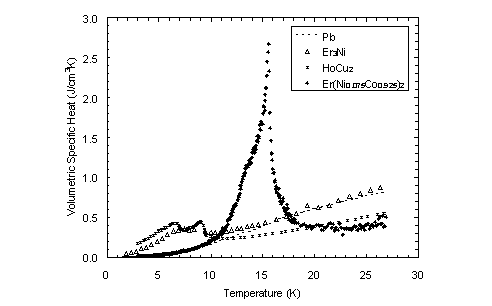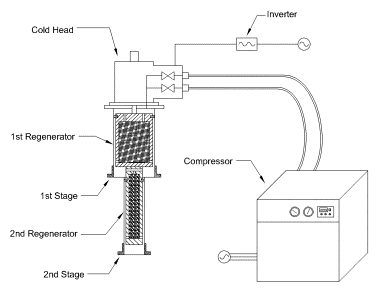
Performance Improvement of a two-stage
Gifford-McMahon cryocooler with Er(Ni0.075Co0.925)2
magnetic regenerator material
(in cooperation with the Department
of Energy Sciences of Tokyo Institute of Technology,
and the Superconductivity
Application Technology Group of
Toshiba Corporation)
A newly developed magnetic regenerator material Er(Ni0.075Co0.925)2, having high specific heat at temperatures from 10 to 20 K, was tested inside the second regenerator of a two-stage GM cryocooler. Different working conditions were examined: four Er(Ni0.075Co0.925)2/Pb material ratios, three displacer reciprocating speeds, and two cryocooler stroke lengths. In the best working conditions, the experimental results show a cooling power improvement up to 15% over the whole temperature range from 10 to 20 K compared to that of the same GM cryocooler employing only lead.
The refrigeration performance of a regenerative-cycle cryocooler (such as Gifford-McMahon, Stirling or pulse tube) greatly depends on the efficiency of the regenerative heat exchanger. This device carries out the heat exchange between the incoming and the outgoing fluids, acting like a thermal sponge by alternately storing and rejecting heat to the fluid. One of the most influent parameter on the regenerator efficiency is the specific heat of the matrix material. The higher the heat capacity of the matrix material, the higher the heat amount storable by the regenerator, allowing a higher overall efficiency of the heat exchanger. The conventional regenerative material utilized at temperatures lower than 80 K is lead (Pb), because of its low price and relatively high specific heat in this temperature range respect to other commonly used materials (such as stainless steel or bronze). However, the specific heat of Pb and other conventional (non magnetic) regenerative materials decreases rapidly with decreasing temperature, becoming lower than that of helium gas below about 10 K. This is the main reason why the lowest temperatures achievable by regenerative-cycle cryocoolers employing conventional matrix materials are limited to about the 8 K level [1].
Since the early 1990s, the development of rare-earth based magnetic regenerator materials, having high specific heat at temperatures lower than 10 K, has allowed the cooling power improvement of regenerative-cycle cryocoolers at very low temperatures, permitting the achievement of working refrigeration temperatures in the liquid helium range [2, 3]. Thanks to the use of rare-hearth compounds having a specific heat peak at low-temperatures, today GM cryocoolers able to achieve cooling powers higher than 1 W at 4.2 K are commercially available [4].
At present, the most widely used magnetic regenerator materials in the cold side of a 4 K regenerator (such as HoCu2 and Er3Ni) exhibit a peak in the volumetric specific heat lower than 1 J/cm3K at low temperature (5÷10 K). Fig. 1 represents the comparison among the specific heat of Pb, HoCu2, Er3Ni and the tested newly developed material Er(Ni0.075Co0.925)2. As shown, the new magnetic material exhibits a high specific heat peak (2.67 J/cm3K) at 15.6 K. On the other hand, its volumetric specific heat becomes comparable with that of lead below 10 K. This makes it not suited to work in the liquid helium range, but a very interesting substitute of Pb at higher temperatures. Recently, research on new superconducting materials is pushing the operative temperatures of cryogen-free systems towards 20 K, stimulating the interest in the development of high-performance cryocoolers for temperatures higher than 10 K.

Figure 1:
Volumetric
specific heat of Pb, HoCu2 and Er3Ni in comparison with
the tested newly developed material Er(Ni0.075Co0.925)2.
In this research, the Er(Ni0.075Co0.925)2 magnetic material has been tested in the cold side of the second regenerator of a two-stage GM cryocooler working at temperatures between 10 and 20 K. Different working conditions have been examined: four Er(Ni,Co)/Pb volumetric ratios (0%, 30%, 50%, 70%), three displacer reciprocating speeds (45.5 rpm, 57.6 rpm, 72.8 rpm), and two cryocooler stroke lengths (20 mm, 32 mm). The purpose of this work has been to find the optimal working condition and establish if the use of the magnetic regenerator material could bring about a cooling power and an efficiency improvement of the GM cryocooler in the temperature range from 10 to 20 K.
Fig. 2 shows a schematic diagram of the experimental apparatus. The cold head was a non commercial Toshiba’s model, with displacers driven by an AC synchronous motor with eccentric cam. The stepping motor was driven by an inverter, so that the displacer reciprocating speed could be set by changing the supply frequency. Using two different cams, it was possible to chose between two different displacer stroke lengths: 20 mm or 32 mm. The inner diameter of the first cylinder was 70 mm, that of the second cylinder 32 mm. So the first and the second expansion volumes were respectively 60.9 cm3 and 16.1 cm3 with 20 mm stroke length, and 97.4 cm3 and 25.7 cm3 with 32 mm stroke length. Fig. 3 shows the cryocooler head and the second regenerator dismounted during the filling operations. For every working configuration, first the performance of the cold head employing only lead shot (diameter 0.20÷0.40 mm) within the second regenerator was measured. Then the Er(Ni0.075Co0.925)2 magnetic material was placed into the cold side of the second regenerator (instead of Pb), and the cooling power compared with that of only lead. To establish the optimal Er(Ni,Co)/Pb ratio, both the experimental and the computer simulation method were used [5]. The results agreed for an optimal Er(Ni,Co)/Pb volumetric ratio equal to about 30%.

Figure 2: Schematic diagram of the experimental apparatus.
|
|
|
|
Figure 3: Cryocooler head and second regenerator dismounted during the filling operations. |
|
At first, the cryocooler working with a displacer stroke length equal to 20 mm was tested. The reciprocating speed was set to 72.8 rpm, while the Er(Ni,Co)/Pb volumetric ratio was changed among four different values (0%, 30%, 50% and 70%). Then, for the second test series with displacer stroke length of 32 mm, the Er(Ni,Co)/Pb volumetric ratio was set to 30% while the reciprocating speed was changed among 45.5 rpm, 57.6 rpm and 72.8 rpm.
Fig. 4 shows the steady-state temperatures and the calculated percentage cooling power improvements thanks to the use of the magnetic regenerator material respect to the case with only lead. From these experimental results, we deduced that the two-layers regenerator with Pb at the warm end and Er(Ni0.075Co0.925)2 at the cold end can lead to an increase in the cooling power of the cryocooler at temperatures from 10 to 20 K. Among the tested configurations, the most favorable was that one with an Er(Ni,Co)/Pb volumetric ratio equal to 30%. For this configuration, the best improvement was at the temperature of about 18 K, where the cooling power from 10.9 W (with only Pb) reached 12 W, corresponding to a percentage improvement of about 10% in the cryocooler cooling power.
|
|
|
|
Figure
4: Steady-state temperatures and calculated
percentage cooling power improvements thanks to the use |
|
In the 32 mm stroke length experimental series, we compared the cryocooler performance with an Er(Ni,Co)/Pb volumetric ratio equal to 30% (which showed to be optimal in the previous experimental series) with the case of only lead within the second regenerator. Moreover, we tested three reciprocating speeds: 45.5 rpm, 57.6 rpm and 72.8 rpm. For each configuration we imposed six different heat loads at the second stage (0 W, 4 W, 8 W, 12 W, 14 W, 16 W) and measured the steady-state temperatures. Again, we found that the two-layers regenerator with Pb at the warm end and Er(Ni0.075Co0.925)2 at the cold end led to an increase in the cooling power of the cryocooler at temperatures from 10 to 20 K. As expected, with longer displacer stroke the cooling power improvement reached higher values. As for the effect of the reciprocating speed, the higher improvement was achieved at 45.5 rpm. For this working condition, the best improvement was at the temperature of 15.2 K, where the cooling power from 10.4 W (with only Pb) reached 12 W, corresponding to a percentage improvement of about 15% in the cryocooler cooling power. At temperatures between 14 and 18 K, the performance improvement was always higher than 10%. Fig. 5 shows the measured cooling power curves at 45.5 rpm and the calculated percentage performance improvements thanks to the use of the magnetic regenerator material respect to the use of only lead.
Since the flowing helium gas per minute is the same with 20 mm stroke length and 72.8 rpm and with 32 mm stroke length and 45.5 rpm (being 20 × 72.8 = 32 × 45.5), it is possible to compare the two working conditions of the cryocooler. Fig. 6 shows a comparison among the cooling power of the cryocooler, for the two cases with only Pb and with an Er(Ni,Co)/Pb volumetric ratio equal to 30%. The configuration with longer stroke length brought about a great cryocooler performance improvement.
|
Figure 5: 2nd stage cooling
power and calculated percentage |
Figure 6: Comparison
among the cooling power curves of the |
In parallel with the experimental activity, a simulation code was developed for regenerative heat exchanger efficiency evaluation. In substance calculation results agreed with experimental data. Fig. 7 shows the calculated efficiency of the second stage regenerator with respect to cooling temperature respectively in the case of 20 mm and 32 mm stroke length. The results show an heat exchange efficiency improvement thanks to the use of the magnetic material. The optimal configuration appears to be with a ratio Er(Ni,Co)/Pb of 30%. Moreover, the improvement is higher in the case of 32 mm stroke length than in the case of 20 mm stroke length.
|
|
|
| Figure 7: Second
stage calculated regenerator efficiency respect to cooling temperature respectively in the case of 20 mm and 32 mm stroke length. |
|
References
| [1] | Walker G. Cryocoolers, Part 2: Applications. New York, Plenum Press, 1983. p. 33-36. | ||
| [2] | Ke G., Makuuchi H., Hashimoto T., Onishi A., Li R., Satoh T., et al. Improvement of a two-stage GM refrigerator performance using a hybrid regenerator. Advances in cryogenic engineering, vol. 40. New York, Plenum Press, 1994. p. 639-47. | ||
| [3] | Kuriyama T., Hakamada R., Nakagome H., Tokai T., Sahashi M., Li R., Yoshida O., Matsumoto K., Hashimoto T. High efficiency two-stage GM refrigerator with magnetic material in the liquid helium temperature region. Advances in cryogenic engineering, vol. 35B. New York, Plenum Press, 1990. p. 1261-69. | ||
| [4] | Satoh T., Onishi A., Li R., Asami H., Kanazawa Y. Development of 1.5W 5K G-M cryocooler with magnetic regenerator material. Advances in cryogenic engineering, vol. 41. New York, Plenum Press, 1996. p. 1631-37. | ||
| [5] | Ackerman R.A. Cryogenic Regenerative Heat Exchangers. New York, Plenum Press, 1997. p. 148-59. |